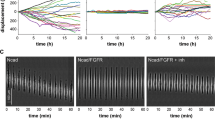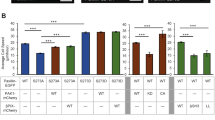Abstract
Protein tyrosine phosphorylation accompanies the inte-grin-mediated cell to substratum adhesion, and is essential for the progression of G1/S phase of the cell-cycle in normal fibroblasts. To examine how cellular protein tyrosine phosphatase (PTPase) activity is involved in regulating the adhesion-dependent protein tyrosine phosphorylation, we employed fibroblast cells bearing an active form of a protein tyrosine kinase (PTK), v-Src. We found that the v-Src induced tyrosine phosphorylation in certain proteins such as tensin, talin, p120, p80/85 (cortactin) and paxillin was greatly reduced when the cell to substratum adhesion was lost. Re-adhesion of the cells onto fibronectin restored these phosphorylation events, while this was inhibited by the addition of RGD peptide. The kinase activity of the v-Src was unchanged by the loss of cell to substratum adhesion. On the other hand, treatment with a protein tyrosine phosphatase inhibitor vanadate caused much the same increase in the v-Src-mediated cellular tyrosine phosphorylation between cells adhered to the culture environments and cells kept in suspension. These data suggest that PTPase(s) appears to be more critical than the v-Src PTK in determining the cell adhesion-dependent protein tyrosine phosphorylation. Moreover, most of the protein tyrosine phosphorylations that are mediated by the v-Src but still dependent on the cell adhesion were indeed greatly reduced during an anchorage-independent growth of v-Src cells. Thus our data collectively indicate that the v-Src induced high level of tyrosine phosphorylation in certain types of proteins are still under the control of the integrin(s) or the cell adhesion to culture substratum, and most of these adhesion-regulated high levels of tyrosine phosphorylations are not essential for the transformed phenotype.
This is a preview of subscription content, access via your institution
Access options
Subscribe to this journal
Receive 50 print issues and online access
$259.00 per year
only $5.18 per issue
Buy this article
- Purchase on Springer Link
- Instant access to full article PDF
Prices may be subject to local taxes which are calculated during checkout
Similar content being viewed by others
Author information
Authors and Affiliations
Rights and permissions
About this article
Cite this article
Sabe, H., Hamaguchi, M. & Hanafusa, H. Cell to substratum adhesion is involved in v-Src-induced cellular protein tyrosine phosphorylation: implication for the adhesion-regulated protein tyrosine phosphatase activity. Oncogene 14, 1779–1788 (1997). https://doi.org/10.1038/sj.onc.1201022
Received:
Revised:
Accepted:
Issue Date:
DOI: https://doi.org/10.1038/sj.onc.1201022



